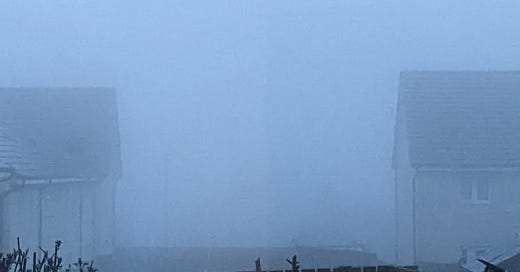I have had the strange, unearthly, earthy experience of watching someone die.
Years ago, now, I sat at the deathbed of someone dear to me. He was a private man, and so I feel obligated to give him some veil of anonymity, even long after his passing. He died slowly, and then altogether was gone. But in between, I held his hand. I watched at his bedside, in the small hours of the night, as his breathing began to draw out. He was asleep, or at least, not awake. It felt as if the slow breathing would continue until morning. But I began to feel a strong sense inside that I ought to wake up others, to tell them to come, now. The urgency was strong, as if the dying man was broadcasting the knowledge into me that this was it, please, get the others.
[I know, rationally - he did not speak to me. I know I did not hear words]
I ran to get others. We sat, we waited. He died. I will never forget, as long as I have capacity to remember, that evening’s strange, terrible ache. The possibility of a message, and my acting to receive it. In the busyness of my days lately, I hadn’t revisited the moment in a long time, but I recently read this guardian article on clinical death - and the possibility of consciousness extending beyond it (for at least a little way). It’s long, but I found it comforting, even though there are no answers.
[there are never any answers, fully, on the wild frontier of death]
“There was another burst of connectivity more than five minutes and 20 seconds after she was taken off life support. In particular, areas of her brain associated with processing conscious experience – areas that are active when we move through the waking world, and when we have vivid dreams – were communicating with those involved in memory formation. So were parts of the brain associated with empathy. Even as she slipped irrevocably deeper into death, something that looked astonishingly like life was taking place.”
(from Alex Blasdel’s piece, linked above)
The idea that consciousnes continues, that even without oxygen, without bodily feedback of even the gentlest sort - our mind continues, might be seen as horrifying. But the piece talks about not receptors of pain buzzing about in the dying mind, but the zones of memory and dreaming, waking thoughts, lighting up, in a wash of seratonin. Perhaps it is the colourful, kindly myth-telling of comfort for the dying, of the life flashing before our eyes, of dreams of heaven
[and here, I add, I do not rule out some transmission into another world, whatever that is taken to be]
I am thinking of the sense of a voice that was not a voice, that was the rhythm of a heartbeat slowing, my intuition of it, or something else, calling to me, between two hands held, in the quiet of a hospital. I am thinking that my belief in such powers - ambiguous as my feelings are - is strangely resistant. What is there, travelling, of ourselves, reaching out to others? In the same room, or in the written word. In art, in music, the something resonates, and has many names, and cannot be known, or ‘got’ or held on to. Afterlives, the sense of a soul, a mind, persisting, even momentarily longer than science appears to have allowed.
Why am I thinking of all this, now?
The warm spring sun. The hands I hold now. An essay I wrote on loss. Revisiting my loved one’s books, like a mind stacked all over the place, but of course, nothing like a mind at all. What is a book? A repository for ideas and creativity, but not alive. Static.
I turn away from books for a moment, and try to live, and dream, right now, with those who live too.





This in between space. The negative space as it is called in the visual arts. The empty space between is what animates all the represented. That space lives in every art. Every potent art. Every book, poem, play, song, built space. It is what I am drawn to always and forever.